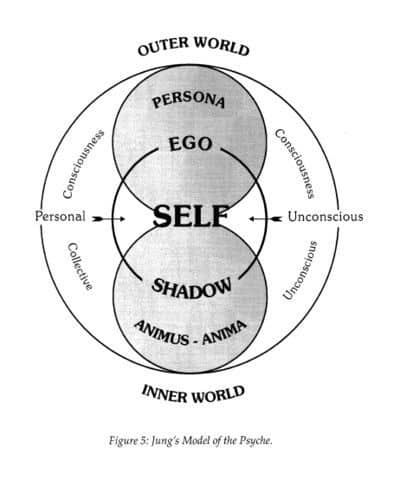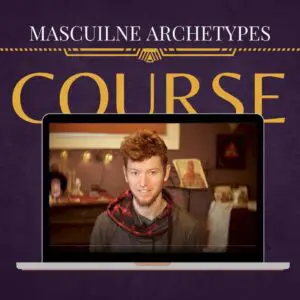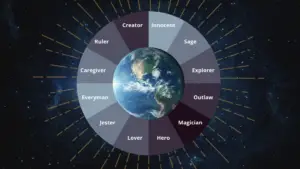Many modern writings on self-development, psychology, Masculinity, and gender studies are grounded in the works of Carl Jung. His work is foundational, and there is much to be gained from understanding the basics of his model of the human psyche.
This article will discuss some of Carl Jung‘s most influential theories he used in the creation of Analytical Psychology, which are still relevant today.
The Collective Unconscious
A cornerstone of Jungian Psychology is the shared collective memory that Carl Jung called The Collective Unconscious. It describes the collective of all human experiences and ideas. It is composed of primordial images from where both dreams and mythical narratives originate.
As Carl Jung and others showed in their work, the unconscious doesn’t reside in just one body but is shared by all of our minds and memories.
Jung believed that knowledge comes from the collective unconscious. He referred to this knowledge as the roots of all religions and philosophy. Jung believed that there were two parts to the collective unconscious, personal and impersonal.
- The Personal is made up of our own unique experiences.
- The Impersonal contains everything we inherit from other people’s lives—images, thoughts, stories, symbols.
When exploring our identity, you are interacting with this collective unconscious. This shared language of symbolism can help us understand on a deeper level who you are, and how you interact with the world.
The 12 Jungian Archetypes
1. The Innocent
2. The Orphan
3. The Hero
4. The Caregiver
5. The Explorer
6. The Rebel
7. The Lover
8. The Creator/Artist
9. The Sage
10. The Jester
11. The Ruler
12. The Magician
Each one of these archetypes shows up in our lives at different times and in different ways. For example, The Innocent is the child inside us all that needs protection and help. Or the Lover archetype as the romantic side of us that possesses love gives it unconditionally and seeks to please the object of one’s attention.
We are each wildly complex, with each of these archetypes living within us. Jung’s Archetypes offer a lens through which to explore your masculine psyche. They are memories that have been passed down through time and help you identify your psyche’s different aspects and parts.
Jung believed that Archetypes were part of our culture’s DNA.
Archetypes are expressions of fundamental human needs, emotions, or behavior patterns that may be more prominent depending on what stage we’re at in life (childhood vs. adulthood).
I like to think of Archetypes as a language you can learn. When you get familiar with the different roles you play, you can consciously move between them. You can see when you are acting from the wounded Orphan archetype or the Father Archetype.
With awareness, if one set of behaviors isn’t working, you can change the archetype you are expressing. So if you are in a fight with a partner, you might ask yourself, “What archetype am I expressing, and what archetypes could be more useful at this moment?“
When embarking on the study of Masculinity, you can find your inner-self through an exploration of archetypes. Through this shared language of symbolism, you can begin to understand yourself and others holding the masculine.
The Shadow
The Shadow is the opposite of the “I” in your personality. It represents the repressed or hidden aspects of your personality, the part of your personality that remains locked away.
The Shadow includes those qualities that you fear most in yourselves: our deepest desires, instincts, impulses, and animalistic needs, as well as everything that you want to deny about being human-your complexes.
The Shadow can be considered an essential aspect of oneself because without this part of you, how would you know what pieces were missing? (e.g., You might not realize your inability to love until someone shows more affection than you are used to.)
It holds the key for growth by revealing things such as weaknesses or hidden strengths within yourself.
Carl Jung believed The Shadow can be found in many ancient cultures and symbols, one of which is the Egyptian Ankh. The Ankh is a symbol that represents eternal life. According to Jungian theory, it could mean returning from darkness into light-which would represent the individual’s progression through the three phases of personal growth:
- Ignorance (Shadow)
- Self Awareness (Ego)
- Wise Old Man/Woman (Wise One)–someone who has transcended Shadow to become a fully functioning person.
I also like to break down the Shadow into three different aspects:
- The Mask, representing what people want from you what they think you should look like.
- The Terror, which embodies worries or fears. Whether for yourself or another person.
- The Cruelty, the dark children within each person that cause them pain as well as those around them.
Facing the Shadow aspects of your masculine identity can be scary. A part of your subconscious may protect these parts from awareness or keep them locked up.
This is why it is essential to face the Shadow to accept that you are who you really are and go forward with your life.
Unless you learn to face your own shadows, you will continue to see them in others, because the world outside you is only a reflection of the world inside you.
-Carl Jung
Anima and Animus
Anima and Animus describe the unconscious masculine side of a woman and the unconscious feminine side of a man. In Jungian psychology, they both transcend the personal psyche, but they are thought to have a complex set of anthropomorphic archetypes that form Self as we know it.
The psyche is such that it contains and embraces both the feminine and masculine. Anima and Animus help to describe how someone views and interacts with the opposite gender within themselves.
Jung described it as:
- Anima: a personification of feminine archetype found within the male psyche (an unconscious quality conceived as a woman).
- Animus: a personification of masculine archetype found within the female psyche (unconscious quality thought to inhabit males)
In Mediated religions, Anima can represent a female’s consciousness while Animus represents the male’s consciousness. The same idea goes for Spirituality where Animus symbolizes masculine energy while Anima represents feminine energy; Myths also show this as
The Anima is often seen as being more intuitive, whereas the Animus can be characterized by rationality and logic. It’s essential for people to process their gender while also understanding how it interacts with other genders–especially when establishing relationships between individuals who may not share a common perception of what they represent.
Anima and Animus ideas help you see the world in a new way. When working with Masculinity, they allow you to see beyond the dualistic nature of gender and begin to see how these two interact with each other.
The Ego
The ego has various functions, including organizing thoughts, feelings, senses, and intuition; regulating memory access; linking into what is outside oneself.
Though a small portion of the psyche, Jung believed the ego selects the most relevant information from the environment and chooses a direction based on it.
Jung described the ego as four core functions that combine to form a sense of Self.
- Sensation
- Thinking
- Feeling
- Intuition
Jung believed that every person starts life with a specific role, based on the four main ego functions. In adulthood, people may choose to change their development to be more self-aware of all four ego functions.
Whenever you work with Masculinity, you explore your ego and identity.
It is crucial to think about what you feel the most stable and align with that gender identity. Evaluating your ego and identity helps you uncover hidden aspects of yourself– helping you find passion for the things that matter to you.

The Self
According to Jung, the self is the sum of one’s conscious and unconscious thoughts. Representing the psyche as a whole and the central executive of all other elements in the psyche. It is the director and center of your personality.
The Self is also associated with a spiritual unification of masculine and feminine essence within everyone. The closer you bring your Shadow, Ego, Anima and Animus together the closer you are to The Self.
For Carl Jung, the Self is the driving force of “individuation” which he described as an ongoing process of integrating various aspects of one’s personality. This process of integration is said to lead an individual to a greater understanding and acceptance of the self.
The Self is:
-
The director of all other aspects of the psyche
-
The totality of your personality
-
The deep and unchanging parts of you
The Persona
Jung said that the Persona is the face that one presents to others and/or society often while concealing their true nature or feelings from other people. It’s the social identity when dealing with other individuals who have a preexisting set of expectations about what roles they should be playing.
When people present their Persona to the world, they often leave out many of the details about themselves that do not fit in with conventional social norms.
The problem with the persona can arise when people become too attached to the face they present in public. When a person is not presenting their true self, it can lead to problems with personal relationships and other people will often grow tired of trying to understand who you really are.
In this way, the Persona is about finding a balance between one’s outer world and the inner world.
In Conclusion
Carl Jung’s work is a fantastic foundation for understanding the psyche. Jungian theory can help you unpack the different aspects of your identity and understand the motivations behind your actions.
Summary of Jungian Theory
- The Collective Unconscious is derived from ancestral memory and experience and is common to all humankind.
- Archetypes are universal symbols that operate as templates to help guide your personalities.
- The Shadow represents the repressed or hidden aspects of your personality.
- Anima and Animus refer to the inner male and female influences that universally affect us.
- The Ego is the center field of consciousness. It is the part of your psyche that forms your consciousness and sense of identity.
- The Self representing the psyche as a whole and the central executive of all other elements in the psyche.
- The Persona is the face that one presents to others
Carl Jung deeply influenced my own work with the HeroRise Masculine Archetype Deck. I found his work to be instrumental in me overcoming past trauma and moving closer to The Self through exploring my Masculinity.




